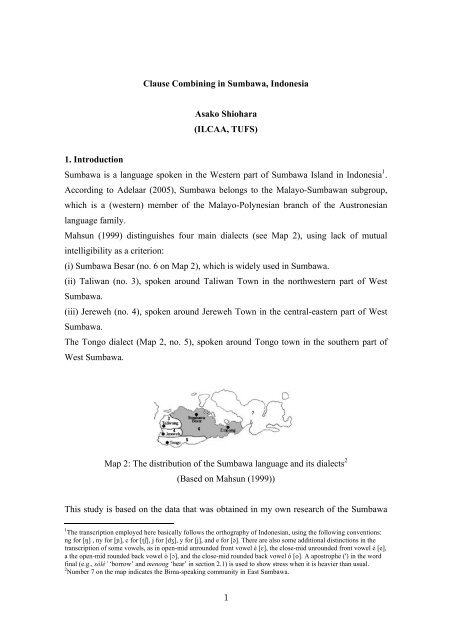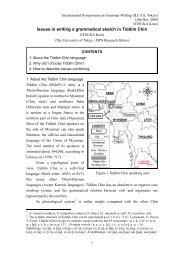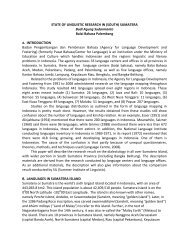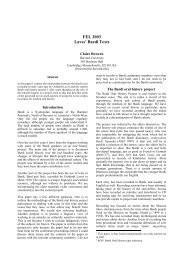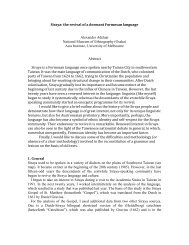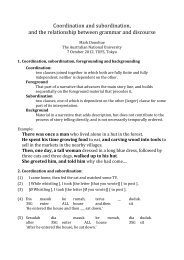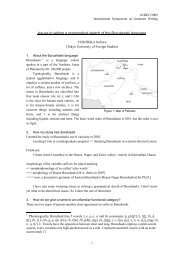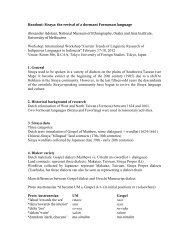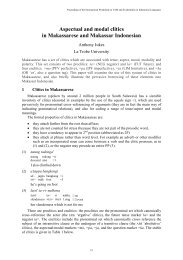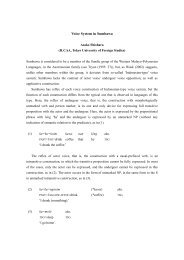1 Clause Combining in Sumbawa, Indonesia Asako Shiohara ...
1 Clause Combining in Sumbawa, Indonesia Asako Shiohara ...
1 Clause Combining in Sumbawa, Indonesia Asako Shiohara ...
You also want an ePaper? Increase the reach of your titles
YUMPU automatically turns print PDFs into web optimized ePapers that Google loves.
1. Introduction<br />
<strong>Clause</strong> <strong>Comb<strong>in</strong><strong>in</strong>g</strong> <strong>in</strong> <strong>Sumbawa</strong>, <strong>Indonesia</strong><br />
<strong>Asako</strong> <strong>Shiohara</strong><br />
(ILCAA, TUFS)<br />
<strong>Sumbawa</strong> is a language spoken <strong>in</strong> the Western part of <strong>Sumbawa</strong> Island <strong>in</strong> <strong>Indonesia</strong> 1 .<br />
Accord<strong>in</strong>g to Adelaar (2005), <strong>Sumbawa</strong> belongs to the Malayo-<strong>Sumbawa</strong>n subgroup,<br />
which is a (western) member of the Malayo-Polynesian branch of the Austronesian<br />
language family.<br />
Mahsun (1999) dist<strong>in</strong>guishes four ma<strong>in</strong> dialects (see Map 2), us<strong>in</strong>g lack of mutual<br />
<strong>in</strong>telligibility as a criterion:<br />
(i) <strong>Sumbawa</strong> Besar (no. 6 on Map 2), which is widely used <strong>in</strong> <strong>Sumbawa</strong>.<br />
(ii) Taliwan (no. 3), spoken around Taliwan Town <strong>in</strong> the northwestern part of West<br />
<strong>Sumbawa</strong>.<br />
(iii) Jereweh (no. 4), spoken around Jereweh Town <strong>in</strong> the central-eastern part of West<br />
<strong>Sumbawa</strong>.<br />
The Tongo dialect (Map 2, no. 5), spoken around Tongo town <strong>in</strong> the southern part of<br />
West <strong>Sumbawa</strong>.<br />
Map 2: The distribution of the <strong>Sumbawa</strong> language and its dialects 2<br />
(Based on Mahsun (1999))<br />
This study is based on the data that was obta<strong>in</strong>ed <strong>in</strong> my own research of the <strong>Sumbawa</strong><br />
1 The transcription employed here basically follows the orthography of <strong>Indonesia</strong>n, us<strong>in</strong>g the follow<strong>in</strong>g conventions:<br />
ng for [ŋ] , ny for [ɲ], c for [tʃ], j for [dʒ], y for [j], and e for [əә]. There are also some additional dist<strong>in</strong>ctions <strong>in</strong> the<br />
transcription of some vowels, as <strong>in</strong> open-mid unrounded front vowel è [ɛ], the close-mid unrounded front vowel é [e],<br />
a the open-mid rounded back vowel ò [ɔ], and the close-mid rounded back vowel ó [o]. A apostrophe (') <strong>in</strong> the word<br />
f<strong>in</strong>al (e.g., sólé’ ‘borrow’ and menong ‘hear’ <strong>in</strong> section 2.1) is used to show stress when it is heavier than usual.<br />
2 Number 7 on the map <strong>in</strong>dicates the Bima-speak<strong>in</strong>g community <strong>in</strong> East <strong>Sumbawa</strong>.<br />
1
Besar dialect 3 and the written text (Jonker (1934)). (It is unknown that when and where<br />
Jonker orig<strong>in</strong>ally obta<strong>in</strong>ed the text.)<br />
This study deals with clause comb<strong>in</strong><strong>in</strong>g <strong>in</strong> <strong>Sumbawa</strong>. After provid<strong>in</strong>g an overview<br />
of the clause comb<strong>in</strong><strong>in</strong>g <strong>in</strong> this language, I will exam<strong>in</strong>e how clause comb<strong>in</strong><strong>in</strong>g occur <strong>in</strong><br />
the narrative texts. We will deal with two texts, one is a relatively old narrative (Jonker<br />
1934) and the other is a relatively recent narrative that I obta<strong>in</strong>ed <strong>in</strong> my own research.<br />
2. Overview<br />
2.1 <strong>Clause</strong> comb<strong>in</strong><strong>in</strong>g with a conjunction<br />
Some adverbial clauses and relative clause is <strong>in</strong>troduced by a conjunction. First I will<br />
give examples of an adverbial clause, and then those of a relative clause.<br />
(a) Adverbial clause<br />
(i) Temporal: senópoka’ ‘before’,sesuda’ ‘after’, setela ‘after’, beru’ ‘just after’, muntu<br />
‘when’<br />
(ii) Conditional: lam<strong>in</strong> ‘if’<br />
(iii) Causal: l<strong>in</strong>g ‘because’,sijar ‘because’, sebab ‘because’, apa ‘for’,<br />
(iv) Concession: kelé’ ‘though’, sedang ‘though’<br />
(v) Purpose: bau + desiderative ma ‘<strong>in</strong> order to’<br />
Most of the adverbial clause is a f<strong>in</strong>ite clause, <strong>in</strong> that it may take the same set of<br />
arguments as an <strong>in</strong>dependent clause does, and the verb can be marked with person<br />
marker and any TAM marker. Only one exception is (v) purpose clause, which normally<br />
(but not obligatorily) occurs with the desiderative modal marker ma.<br />
Most of the adverbial clauses may precede or follows the ma<strong>in</strong> clause. Only the<br />
exception is a clause with apa ‘because’. It always follows the ma<strong>in</strong> clause.<br />
(i) Temporal: senópoka’ ‘before’,sesuda’ ‘after’, setela ‘after’, beru’ ‘just after’, muntu<br />
3 See <strong>Shiohara</strong> (2012) on the status of this dialect. The data on which this paper is based was collected <strong>in</strong> towns of<br />
<strong>Sumbawa</strong> Besar and Empang dur<strong>in</strong>g fieldwork periods of altogether approximately 10 months between 1996 and<br />
2010. I am grateful to the people who assisted me <strong>in</strong> my research, especially Dedy Muliyadi (Edot), Pap<strong>in</strong> Agang<br />
Patawari (Dea Pap<strong>in</strong> Dea R<strong>in</strong>ggi), and the late P<strong>in</strong> Awak (Siti Hawa).<br />
2
‘when’<br />
(1) senópoka’ ku=mangan ku=man<strong>in</strong>g’.<br />
before 1SG=have a meal 1 SG =have a shower<br />
‘I took a shower before I had breakfast.’ [elicited]<br />
(2) sesuda’ ku=mangan, ku=manéng’.<br />
after 1SG=have a meal 1SG =have a shower<br />
‘I took a shower after I had breakfast.’ [elicited]<br />
(3) setela ka mo ngibar adè enam,<br />
after past mm fly rel six<br />
batada kan dèta.<br />
Rema<strong>in</strong> <strong>in</strong>terj this<br />
“After the six (girls) flied away, this girl was left beh<strong>in</strong>d”. [LK 053]<br />
(4) muntu ku=mopo, datang nya.<br />
when 1SG=launder come 3<br />
“When I was go<strong>in</strong>g my wash, he came.” [elicited]<br />
(5) beru’ ka=m=tu=kukés né,<br />
(ii) Conditional<br />
lam<strong>in</strong> ‘if’<br />
just.after past=mm=1PL=steam INTERJ<br />
ba=t=tedéng sugan, na.<br />
<strong>in</strong>terj=1PL=put on a stove pan INTERJ<br />
“Just after we steam (the rice), we will put a pan onto a stove”. [Wajik]<br />
(6) lamén saté’ mu=tutét ku, mu=datang mo.<br />
If like 2sg=follow 1sg 2sg=come MM‘If<br />
you want to follow me, just come”. [LK134]<br />
3
(iii) Causal<br />
l<strong>in</strong>g ‘because’, apa ‘for’, sijar ‘because’, sebab ‘because’,<br />
(7) léng nó mo bau’ tahan<br />
because neg mm can stand<br />
laló mo si=Ijo ta.<br />
Go mm title=Ijo this<br />
“Because she couldn’t stand any more, Ijo went out”. [IJO]<br />
(8) ada’ pitu’ pégó, apa pitu’ tau.<br />
(iv) Concession<br />
Exist seven pot because seven person<br />
“There are seven pots, for there are seven people”. [LK022]<br />
kelé’ ‘although’, walaupon ‘although’, sedang ‘although’<br />
(9) béló’ gama umir tu, Edot,<br />
long INTERJ (I hope) age 1PL Edot<br />
kele’ ta lók-lók rabuya bibi mu=ta é.. nanta.<br />
although this way live aunt 2sg=this INTERJ INTERJ<br />
“I hope we could live long, although our life is like this”. [PA125]<br />
(10) dadi lalu=Sangkilang ta nongka samaté’<br />
then title=Sangkilang this NEG.PERF kill<br />
walaupón ka=nyongong<br />
although PAST=look.up<br />
sedang lam<strong>in</strong> tau=l<strong>in</strong>=nan nyongong mesti samaté’<br />
although if people=other=that look.up surely kill<br />
l<strong>in</strong>g’ datu=Basangè-Jaran ta.<br />
By headman=Basangè-Jaran this<br />
4
(v) Purpose<br />
“Then, Lalu Sangkilang was not killed, although he looked up (to the k<strong>in</strong>g),<br />
although if other people had looked up, they must have been killed by the<br />
Horse Headed K<strong>in</strong>g.” [History 058]<br />
As mentioned above, a purpose clause is <strong>in</strong>dicated by the conjunction bau, and the verb<br />
is normally marked with the desiderative marker ma=.<br />
In an <strong>in</strong>dependent clause, the clause with ma= <strong>in</strong>dicates request or <strong>in</strong>vitation.<br />
(11) ma=ku=pukél boat nya.<br />
MA=1SG=hit mouth 3<br />
“May I hit his mouth?” or “Let me hit his mouth.”<br />
(12) ma=sia=datang kota.<br />
MA=2SG+HON=come to-here<br />
“Please come here.”<br />
Sentence (13) and (14) is an example of a purpose clause.<br />
(13) ada’ rasa iri <strong>in</strong>a=ta ké’ adi=ta.<br />
exist feel jealous mother=this with younger-sibl<strong>in</strong>g=this<br />
saté ya=racén si=Ijo=ta, bau ma=dapat selaki’.<br />
want IRR=poison TITLE=Ijo=this can MA=get husband<br />
“The mother and the younger sister (of Ijo) felt jealous, and they wanted to<br />
poison Ijo, so that the sister could get her (Ijo’s) husband 4 .”<br />
(14) ai’ gula, nó si, bau ma=lèma’ gat<br />
water sugar NEG AMP can MA=early concentrated<br />
(when be<strong>in</strong>g asked if much sugared water should be put <strong>in</strong> the pan when<br />
beg<strong>in</strong>n<strong>in</strong>g to cook rice pudd<strong>in</strong>g) “Not (so much) sugared water (is put <strong>in</strong>), so<br />
that it is concentrated earlier.”<br />
4 This example is cited from a folktale. A storyl<strong>in</strong>e of the folktale, which is normally told <strong>in</strong> the past tense <strong>in</strong> English,<br />
as <strong>in</strong> English translation here, is often told without the past-tense marker ka <strong>in</strong> <strong>Sumbawa</strong>.<br />
5
(b) Relative clause<br />
A relative clause is <strong>in</strong>troduced by the conjunction adè (dè). Its function is similar to<br />
yang <strong>in</strong> Malay. Sentence (15) is an example of a relative clause observed <strong>in</strong> spontaneous<br />
utterance of a native speaker.<br />
(15) ta nya [alat dè ya=kenang]<br />
This 3 tool rel 3=use<br />
ya nan si berang atawa lad<strong>in</strong>g.<br />
that is sward or knife<br />
‘This is a tool that is used (for the purpose), that is, a sward or a knife.<br />
[Palm leaf sugar]<br />
S of an <strong>in</strong>transitive clause or A, P, or a recipient NP of a transitive clause may be<br />
relativized by the clause of adè. Sentence (16) and (17) are examples of an <strong>in</strong>transitive<br />
relative clause.<br />
(16) tau [adè balong ké aku]<br />
person REL good com 1sg<br />
“A person who is good (k<strong>in</strong>d) to me”<br />
(17) tau [adè lalo kona’]<br />
person REL go there<br />
“A person who went there”<br />
Sentence (18)b-(18)c are examples of a relative clause, which corresponds to a<br />
transitive clause (18)a. In example (18b), P is relativised, while <strong>in</strong> example (18c), A is<br />
relativised.<br />
(18)a ya=tari anak nya l<strong>in</strong>g <strong>in</strong>a nan<br />
3=wait child 3 by mother that<br />
“The mother waits for her child”.<br />
6
(18)b anak [adè ya=tari φ l<strong>in</strong>g <strong>in</strong>a nan]<br />
person REL 3=wait by mother that<br />
“A child whom his mother waits for”<br />
(18)c <strong>in</strong>a [adè φ=tari anak nya]<br />
mother that 0=wait child 3<br />
“A mother who waits for her child”<br />
An NP that corresponds to the relativized (head) NP does not appear with<strong>in</strong> a relative<br />
clause itself <strong>in</strong> <strong>Sumbawa</strong>. Examples (18)d-(18)g that do not fill the condition are not<br />
accepted by a native speaker.<br />
(18)d *anak [adè ya=tari anak nya l<strong>in</strong>g <strong>in</strong>a nan]<br />
person REL 3=wait child 3 by mother that<br />
(Intended mean<strong>in</strong>g) “A child whom his mother waits for”<br />
(18)e *anak [adè ya=tari nya l<strong>in</strong>g <strong>in</strong>a nan]<br />
person REL 3=wait 3 by mother that<br />
(Intended mean<strong>in</strong>g) “A child whom his mother waits for”<br />
(18)f *<strong>in</strong>a [adè φ=tari anak nya l<strong>in</strong>g <strong>in</strong>a nya]<br />
mother that 0=wait child 3 by mother 3<br />
(Intended mean<strong>in</strong>g) “A mother who waits for her child”<br />
(18)g *<strong>in</strong>a [adè φ=tari anak nya l<strong>in</strong>g nya]<br />
mother that 0=wait child 3 by 3<br />
(Intended mean<strong>in</strong>g) “A mother who waits for her child”<br />
In <strong>Sumbawa</strong>, a person marker <strong>in</strong>dicat<strong>in</strong>g the person of A precedes to a verb, as ya=<br />
‘third person’ <strong>in</strong> (18)a. When A is relativised, the person marker, as well as an<br />
<strong>in</strong>dependent NP <strong>in</strong>dicat<strong>in</strong>g A, may not occur with<strong>in</strong> a relative clause. Example (18)f,<br />
therefore, is not accepted by a native speaker.<br />
7
(18)f *<strong>in</strong>a [adè ya=tari anak nya]<br />
mother that 3=wait child 3<br />
(Intended mean<strong>in</strong>g) “A mother who waits for her child”<br />
Sentences (20)-(22) are examples of a relative clause, which corresponds to a<br />
semantically ditransitive clause (19). In this case, a recipient NP is relativized as <strong>in</strong><br />
example (20), as well as A, as <strong>in</strong> (21), and P (theme-NP), as <strong>in</strong> (22).<br />
(19) ya=bèang’ lamong l<strong>in</strong>g <strong>in</strong>a nan lakó anak nya<br />
3=wait clothes by mother that to child 3<br />
“The mother gave a clothes to her child”.<br />
(20) <strong>in</strong>a [adè φ=bèang lamong lakó anak nya]<br />
person REL 0=give clothes to child 3<br />
“A mother who gives clothes to her child”<br />
(21) lamong [adè φ=bèang l<strong>in</strong>g <strong>in</strong>a lakó anak nya]<br />
person REL 0=give by mother to child 3<br />
“Clothes that the mother gives to her child”<br />
(22) anak [adè ya=bèang φ l<strong>in</strong>g <strong>in</strong>a nan]<br />
person REL 3=give by mother that<br />
“A child to whom his mother gives clothes”<br />
2.2 <strong>Clause</strong> comb<strong>in</strong><strong>in</strong>g without a conjunction<br />
Various semantic relations are expressed by a comb<strong>in</strong>ed clause without a conjunction<br />
<strong>in</strong> <strong>Sumbawa</strong>. It may be grouped <strong>in</strong>to subord<strong>in</strong>ated type or coord<strong>in</strong>ated type.<br />
2.2.1 Subord<strong>in</strong>ated type<br />
This type can be grouped <strong>in</strong>to the follow<strong>in</strong>g subgroups.<br />
(a) Complementation<br />
(b) Movement and its device<br />
(c) Sentiment and stimulus<br />
8
(d) Manner and action<br />
(e) Instrumental or Commitative<br />
(a) Complementation<br />
(i) Full clause complement type<br />
Some verbs take a full clause as a complement. Such verbs <strong>in</strong>clude the speech-act verbs,<br />
such as bl<strong>in</strong>g ‘say’, bada ‘tell’ and the cognitive verbs, such as gita ‘see’ and to’ ‘know’.<br />
Sentences (23)a and b are examples of the verb to’ ‘know’. A complement clause may<br />
either follow the other argument, as <strong>in</strong> sentence (23)a or may precede it, as <strong>in</strong> sentence<br />
(23)b.<br />
to’ ‘know’<br />
(23)a to’ l<strong>in</strong>g nya=Amén [mólé’ si=Siti].<br />
know by title=Amén go.home title=Siti<br />
“Am<strong>in</strong> knew that Siti went home.”<br />
(23)b to’ [si=Siti mólé’] l<strong>in</strong>g nya=Amén.<br />
know go.home title=Siti by title=Amén<br />
‘Am<strong>in</strong> knew that Siti went home.’<br />
In this case, the property of the complement clause is same as an ord<strong>in</strong>ary <strong>in</strong>dependent<br />
clause, and there are not any mark<strong>in</strong>g of complementation between the ma<strong>in</strong> clause and<br />
the compliment clause. Only the possibility of <strong>in</strong>sertion as seen <strong>in</strong> (23)b exhibits its<br />
dependence to the ma<strong>in</strong> clause.<br />
(ii) non-full clause complement type<br />
Some verbs, such as suru ‘order’or a permission beang ‘permit’ take this type of<br />
complement clause. In this case, the actor NP of the compliment clause is expressed as<br />
an undergoer NP of a ma<strong>in</strong> clause, and the content of the command or permission<br />
occurs as a non-full clause complement.<br />
(24)a ya=suru’ aku léng nya=Amén [beli jangan=nan]<br />
3=order 1SG by title=Amén buy fish=that<br />
“Am<strong>in</strong> tells me to buy the fish.”<br />
9
(25)a ya=beang si=Siti léng nya=Amén [beli jangan=nan]<br />
order title=Siti by title=Amén buy fish=that<br />
“Am<strong>in</strong> has/ allows Siti to buy the fish.”<br />
The complement clause may either precedes the other complement(s) or follow it/ them.<br />
(24)b ya=suru’ [beli jangan=nan] aku léng nya=Amén<br />
3=order buy fish=that 1SG by title=Amén<br />
“Am<strong>in</strong> tells me to buy the fish.”<br />
(25)b ya=beang [beli jangan=nan] si=Siti léng nya=Amén<br />
3=order buy fish=that title=Siti by title=Amén<br />
“Am<strong>in</strong> has/ allows Siti to buy the fish.”<br />
The complement clause is non-full clause, <strong>in</strong> that the constituent that is cross-referent to<br />
the undergoer NP of the ma<strong>in</strong> clause does not occur <strong>in</strong> the complement clause. Sentence<br />
(24)c and (25)c, which does not fill the condition, is not accepted by a native speaker.<br />
The constituent which is cross-referent to the undergoer NP cannot occur <strong>in</strong> a<br />
complement clause either as an <strong>in</strong>dependent NP or pronom<strong>in</strong>al clitic.<br />
(24)c *ya=suru’ aku léng nya=Amén [ku=beli jangan=nan]<br />
3=order 1SG by title=Amén 1SG=buy fish=that<br />
(Intended mean<strong>in</strong>g) “Am<strong>in</strong> tells me to buy the fish.”<br />
(25)c *ya=beang si=Siti léng nya=Amén<br />
3=order title=Siti by title=Amén<br />
[ya=beli l<strong>in</strong>g si=Siti (nya) jangan=nan]<br />
3=buy buy title=Siti (3) fish=that<br />
(Intended mean<strong>in</strong>g) “Am<strong>in</strong> has/ allows Siti to buy the fish.”<br />
Some verbs may function as a ma<strong>in</strong> verb <strong>in</strong> both types of construction. Such verbs<br />
10
<strong>in</strong>clude sadu’ ‘believe’, gita’ ‘see’, angóp ‘guarantee’, setuju ‘agree’, bajangi<br />
‘promise’ , bada’ ‘tell’, totang’ ‘remember’, kalupa’ ‘forgot’<br />
The same proposition can be denoted by a different construction when one of these<br />
verbs occurs as a ma<strong>in</strong> verb.<br />
(26) ya=gita’ si=Siti léng nya=Amén [kakan’ tepóng=nan].<br />
3=see title=Siti by title=Amén eat cake=that<br />
“Am<strong>in</strong> sees Siti eat<strong>in</strong>g the cake”.<br />
(27) ya=gita’ léng nya=Amén [ya=kakan’ tepóng=nan l<strong>in</strong>g Si Siti].<br />
3=see by title=Amén 3=eat cake=that by title Siti<br />
“Am<strong>in</strong> sees that Siti eats cake”.<br />
In the follow<strong>in</strong>g four types, the situation expressed by the ma<strong>in</strong> clause and that by the<br />
subord<strong>in</strong>ate clause shares the actor, and the subord<strong>in</strong>ate clause occurs as a non-full<br />
clause; the constituent express<strong>in</strong>g the actor may not occur <strong>in</strong> a subord<strong>in</strong>ate clause.<br />
(b) Movement and its device<br />
When the ma<strong>in</strong> verb denotes a movement (e.g., laló ‘go’, molé ‘go home’), the non-full<br />
clause express<strong>in</strong>g its device may follow the ma<strong>in</strong> verb.<br />
(28) ku=laló [φ=entèk ojèk=nan] Aku.<br />
1SG =go 0=ride bike-taxi=that 1SG<br />
“I go by ojek (bike-taxi)”.<br />
(c) Emotion and the cause<br />
When the ma<strong>in</strong> verb denotes an emotion (e.g., ketakit ‘scared’, bosan ‘bored’), the<br />
non-full clause express<strong>in</strong>g its cause may follow the ma<strong>in</strong> verb.<br />
(29) ku=ketakit aku [φ=lés mèsa’].<br />
1SG =scared 1SG 0=go alone.<br />
“I go out alone with fear”.<br />
(d) Manner and action<br />
When the ma<strong>in</strong> verb denotes a state (e.g., sibuk ‘busy’, lè ‘slowly’), the non-full clause<br />
11
express<strong>in</strong>g an action may follow the ma<strong>in</strong> verb. In this subtype, too, the ma<strong>in</strong> clause and<br />
the complement clause share the actor, and the constituent to express it does not occur<br />
<strong>in</strong> the complement clause.<br />
(30) ku=sibók [φ=p<strong>in</strong>a’ tepóng=nan] aku<br />
1sg=busy make cake=that 1SG<br />
“I am busy makng the cake.”<br />
(e) <strong>in</strong>strumental and commitative<br />
The verb berma ‘do someth<strong>in</strong>g with’ and kènang’ ‘use’ may form a non-full clause, and<br />
may play a role similar to commutative NP and <strong>in</strong>strumental NP, respectively. In this<br />
subtype, too, the ma<strong>in</strong> clause and the complement clause share the actor, and the<br />
constituent to express it does not occur <strong>in</strong> the complement clause.<br />
(31) ku=p<strong>in</strong>a’ tepóng=nan [φ=berma ké’ <strong>in</strong>a’ ku]<br />
1SG=make cake=the accompany with mother 1SG<br />
“I make the cake with my mother”<br />
(32) ku=mongka’ [φ=kènang’ pamongka=ta] aku.<br />
1SG=cook.rice use cooker=this 1SG<br />
“I cook rice with this rice cooker.”<br />
2.2.2 Coord<strong>in</strong>ated type<br />
Parataxis of this type expresses various semantic relations. Such semantic relation<br />
<strong>in</strong>cludes the follow<strong>in</strong>g category. This list is not exhaustive one. Only the typical<br />
semantic relations <strong>in</strong>dicated by parataxis are given here. (The labels of the relations are<br />
based on the notional catalogue that is suggested <strong>in</strong> Longacre (2007: 377-386), which<br />
he calls ‘notions that encode with<strong>in</strong> sentence structure’.)<br />
3.2.1 Coupl<strong>in</strong>g<br />
Parataxis is often observed, when two situations are considered to be a pair <strong>in</strong> some way,<br />
as <strong>in</strong> sentence (33).<br />
12
(33)<br />
sópó’ waktu <strong>in</strong>a’ tuja’=padé,<br />
one time mother pound=rice<br />
anak ya=satokal mo pang’ bao batu=Langléló=ta<br />
child cons=sit MM at on stone=Langléló=this<br />
“One day, the mother was poud<strong>in</strong>g rice, and the children was made sat on the Langlelo<br />
Stone.” [flat stone]<br />
3.2.2 Introducion (‘Deixis’ <strong>in</strong> Longacre (2007: 377-386))<br />
(34)<br />
Ada sopo tau, Pomponge s<strong>in</strong>g<strong>in</strong>,<br />
Exist one person Pomponge name<br />
Pasang kodong l<strong>in</strong>g tënga rau,<br />
Set trap at middle field.<br />
“There was once a man called Pomponge, [who] set a trap <strong>in</strong> the middle of a dry<br />
field”<br />
3.2.3 Paraphrase<br />
(35)<br />
(One day, the mother was pound<strong>in</strong>g rice, and the children was made sat on the Langlelo<br />
Stone.)<br />
nó.poka’ basebo, nó.poka’ mangan<br />
neg.yet have.breakfast neg.yet eat<br />
“They had not had breakfast, they had not had a meal”<br />
(36)<br />
sedang lè’ malóm tódé’ anak=ta kan<br />
although long as.you.know <strong>in</strong>fant child=this INTERJ<br />
13
masi tódé’<br />
still child<br />
nó po to’ berpikér nó po to’ apa<br />
NEG MM know th<strong>in</strong>k NEG MM know anyth<strong>in</strong>g<br />
“Although it takes more time to cook rice, as you know, the children were <strong>in</strong>fant, (they)<br />
didn’t have sense, they didn’t know anyth<strong>in</strong>g, (they cont<strong>in</strong>ued to ask their mother for<br />
food.)”<br />
3.2.4 Succession (Successive events)<br />
(37)<br />
ètè’ péné’ api=ta ba’ kakan’ mo<br />
take short fire=this so eat mm<br />
sentèk mo pamongka’ lakó’ bao=senikan<br />
put.onto MM rice.cooker to on=stove<br />
bakala’ mo pamongka=ta<br />
boil MM rice.cooker=this<br />
“To make a long story short, the fire was made, (the mother) put a rice cooker onto the<br />
stove, then the cooker was boiled.”<br />
(38)<br />
ètè’ péné’ masak mè ya=óló’ mo kó’ piréng ya=óló’ mo kó’ talang<br />
take short cooked rice CONS=put MM to dish cons=put MM to dish<br />
“To make a long story short, the rice was cooked, and she (the mother) put it on a<br />
dish…”<br />
4 Comb<strong>in</strong>ed clauses that is observed <strong>in</strong> two narratives<br />
In this section, I will exam<strong>in</strong>e how comb<strong>in</strong>ed clauses actually appear <strong>in</strong> narratives. I<br />
used two narratives as a data; one is an oral folklore titled “the story of a flat stone”,<br />
which is collected by the present author, the other is a written text (“text I”, tentatively<br />
titled as “the story of Salam” here), which is selected from Jonker (1935).<br />
“The story of a flat stone” is obta<strong>in</strong>ed by my own research <strong>in</strong> Empang city <strong>in</strong> 1996.<br />
The storyteller is a man called Dea R<strong>in</strong>ggi, born <strong>in</strong> 1930’s. “The story of Salam” is one<br />
14
of <strong>Sumbawa</strong> folktales that Jonker gathered. It cited it from Jonker (1935), which is<br />
published with <strong>in</strong>troduction written by P. Voorhoeve after Jonker’ death. Accord<strong>in</strong>g to<br />
the <strong>in</strong>troduction, this story had been published <strong>in</strong> 1907 before it is published as a<br />
collection of folktales <strong>in</strong> Jonker (1935). It is not known when and where Jonker<br />
orig<strong>in</strong>ally obta<strong>in</strong>ed the text, but it is clear that it reflects the <strong>Sumbawa</strong> language no later<br />
than 1907. In the follow<strong>in</strong>g part of this section, I will exam<strong>in</strong>e how clause comb<strong>in</strong><strong>in</strong>g<br />
occurs <strong>in</strong> each textst to f<strong>in</strong>d the difference between the two texts, and between the<br />
language of relatively younger age, which we can see <strong>in</strong> the elicited data seen <strong>in</strong> this<br />
study.<br />
Text type The year of the speaker’s birth<br />
The story of Salam (Jonker (1935)) (estimated) before 1890’s, at the latest<br />
The story of a flat stone (<strong>Shiohara</strong> (2006)) 1930’s<br />
Ellicited sentences 1975<br />
First, we will exam<strong>in</strong>e the frequency of a comb<strong>in</strong>ed clause with/ without a<br />
conjunction.<br />
As for parataxis, it is difficult to make a totally objective judgment as to if more than<br />
one clause is comb<strong>in</strong>ed (make a unit) or not. But I tried to make as objective judgment<br />
as possible us<strong>in</strong>g a phonological unit and punctuation as a clue. As to the oral text that I<br />
gathered (<strong>Shiohara</strong> (2006)), I judged the more than one clause form a unit, when they<br />
make a phonological unit, and can be considered to have some semantic relation.<br />
I will give an examples from each texts. This is the beg<strong>in</strong>n<strong>in</strong>g of the story “Flat<br />
Stone”. The first two clauses can safely be judged as a unit, as the two clauses that are<br />
<strong>in</strong>cluded here makes a phonological unit, and make a semantic relation of ‘<strong>in</strong>troduc<strong>in</strong>g’.<br />
Similarly, the next two clauses can be considered to form a unit, <strong>in</strong>dicat<strong>in</strong>g a semantic<br />
relation of ‘coupl<strong>in</strong>g’.<br />
(38)<br />
(a) saman dunóng’ ana ada’ sópó’ keluarga,<br />
time before over.there exist one family<br />
(b) dua anak<br />
two child<br />
“There is a family with two children,<br />
(c) soai sa-kodèng,<br />
female one-person<br />
(d) salaki sa-kodèng<br />
male one-person<br />
“One girl and one boy.”<br />
15
As for a written text (“The story of Salam), I made a judgment accord<strong>in</strong>g to Jonker’s<br />
punctuation. (39) is the beg<strong>in</strong>n<strong>in</strong>g of the story of Salam. Three clauses are comb<strong>in</strong>ed<br />
with a comma and form a sentence, which could be called ‘a unit’ 5 .<br />
(39)<br />
Ada sanompo tau misk<strong>in</strong>,<br />
Exist one person poor<br />
ada anak sopo bas<strong>in</strong>g<strong>in</strong> Salam, ia=antat ngaji.<br />
Exist child one named Salam, 3=take ngaji<br />
“There was once a poor man who had a son by the name of Salam, whom he sent to<br />
school (ngaji).”<br />
(lit. There was once a poor man, there was a child named Salam, he took (the son)<br />
ngaji.)<br />
Table 1 presents the number of clauses and units with/ without a conjunction <strong>in</strong> each<br />
text. The frequency of the conjunction is higher <strong>in</strong> the more recent text than the older<br />
one.<br />
Table 1 number of clauses and units<br />
Story of a flat stone<br />
(<strong>Shiohara</strong> 2012)<br />
16<br />
Story of Salam (Jonker<br />
1934)<br />
<strong>Clause</strong> 177 267<br />
Units of comb<strong>in</strong>ed clause 92 133<br />
Units with a conjunction 33 19<br />
Units without a<br />
conjunction<br />
59 114<br />
Dependent type 10 25<br />
Independent type 49 89<br />
Table 2 shows a list of conjunctions and its frequency.<br />
5 In cit<strong>in</strong>g from Jonker (1935), the orig<strong>in</strong>al orthography is reta<strong>in</strong>ed. The text is translated by Stuart Robson<br />
from the orig<strong>in</strong>al Dutch and is glossed by the present author.
Table 2 Conjunctions observed <strong>in</strong> each text<br />
Story of a flat stone<br />
(<strong>Shiohara</strong> 2012)<br />
Units with conjunction 33 19<br />
lam<strong>in</strong> (condition) ‘if’ 7 1<br />
narang (overlap) ‘the more…<br />
the more’<br />
tapi (reversal expectation)<br />
‘but’<br />
6 0<br />
6 0<br />
apa (reason) ‘because’ 3 7<br />
karena (reason) ‘because’ 2 0<br />
bau (purpose) ‘so that’ 2 0<br />
mutu/ muntu (overlap) ‘when’ 2 1<br />
sebab (reason) ‘because’ 1 0<br />
sedang (concession) ‘though’ 1 0<br />
mak<strong>in</strong> (overlap) ‘the more…<br />
the more’<br />
1 0<br />
beru (successive) 1 0<br />
seolaola (simile) ‘like’ 1 0<br />
ame (purpose/ result) ‘so that’ 0 8<br />
mana (concession) ‘even’ 0 1<br />
mengka (successive) ‘just<br />
after’<br />
What we could say from the list is as follows.<br />
0 1<br />
17<br />
Story of Salam (Jonker<br />
1934)<br />
(1) The conjunction lam<strong>in</strong> and narang is frequently occurs <strong>in</strong> the story of a flat stone 6 .<br />
6 The outl<strong>in</strong>e of the story of a flat stone is as follows.<br />
-------------------<br />
Long time ago, there was a flat stone called Batu Langlelo. The mother was cook<strong>in</strong>g, while the children were play<strong>in</strong>g<br />
on the stone. In the meantime, the stone went higher and the mother was not able to give her children food. The<br />
mother visited a couple of quail. They recited a charm many times, and the stone recovered to its orig<strong>in</strong>al height.<br />
-------------------<br />
The conjunction lam<strong>in</strong> occurs <strong>in</strong> a charm that the quails recited. The charm is repeated three times <strong>in</strong> the whole story.<br />
bét béló’ bét péné’ lamén=béló’<br />
bét long bét short if=long<br />
ya=ku=jengkal lamén=péné’
But that is brought about the contents of the story, not by the style of the language itself.<br />
(2) The higher frequency of the conjunction <strong>in</strong>dicat<strong>in</strong>g ‘reason’ is remarkable <strong>in</strong> both<br />
text.<br />
(3) The variety of conjunction <strong>in</strong> the older text is relatively small. For example, it is<br />
only one conjunction <strong>in</strong>dicat<strong>in</strong>g reason (apa ‘beause)) that is attested there, while the<br />
two conjunctions, karena and sebab,nwhich may be a relatively recent loan from<br />
<strong>Indonesia</strong>n, are observed <strong>in</strong> the relatively recent text, <strong>in</strong> addition to apa.<br />
(4) The conjunction ame (purpuse/ result) ‘so that’ is most frequently observed <strong>in</strong> the<br />
older text. The conjunction is not attested <strong>in</strong> my data that is obta<strong>in</strong>ed <strong>in</strong> <strong>Sumbawa</strong> Besar<br />
dialect speak<strong>in</strong>g area.<br />
(40) “Lalo ete sampi ode nan,<br />
go take cow small that<br />
ame tu-semele”<br />
so.that 1pl-kill<br />
“Go and take the small cow, so that we can kill it”.<br />
Table 3 shows the frequency of complementation.<br />
cons=1sg.low.affix=measure.<strong>in</strong>.span.of.the.hand if=short<br />
ya=ku=depa<br />
cons=1sg.low.affix=measure.with.arms<br />
The conjunction narang ‘the more’ occurs <strong>in</strong> the po<strong>in</strong>ts <strong>in</strong> which the storyteller tells the way <strong>in</strong> which the stone<br />
went higher. The similar expression is repeated four times <strong>in</strong> the whole story.<br />
ba’ batu=ta <strong>in</strong>a’ é narang lè’ kan narang t<strong>in</strong>ggi<br />
so stone=this mother you.know the.more long isn't.it? the.more high<br />
“Mother, the stone becomes higher as time goes by.”<br />
18
Table 3 Occurrence of complementation<br />
Story of a flat stone<br />
(<strong>Shiohara</strong> 2012)<br />
Complementation 10 25<br />
19<br />
Story of Salam (Jonker<br />
1934)<br />
Most of the complementation has a verb of speech-act as its ma<strong>in</strong> verb, and most of<br />
them are a full-clause type seen <strong>in</strong> 2.2.<br />
(41) karéng bléng mo anak<br />
and.then say mm child<br />
[<strong>in</strong>a’ <strong>in</strong>a’ ènèng=mè gama <strong>in</strong>a’]<br />
mother mother beg=rice please mother<br />
“Then, the children said, “Mother, mother give us food!”<br />
The character’s words often appear without a speech-act verb <strong>in</strong> both texts.<br />
(41) ia-pukil: “Loka dadi tau dadara”,<br />
3-hit old become person young<br />
sampe mate sowai guru.<br />
Until die woman teacher<br />
“He hit her (say<strong>in</strong>g) ‘The old (woman) become young girl’, until the female<br />
teacher (his wife) died”. (Jonker (1935: 220))<br />
Table 4 shows the list and its frequency of semantic relations that are <strong>in</strong>dicated by<br />
coord<strong>in</strong>ation type of juxtaposition.
Table 4 Semantic relations that are <strong>in</strong>dicated by coord<strong>in</strong>ation type of juxtaposition<br />
Story of a flat stone<br />
(<strong>Shiohara</strong> 2012)<br />
Units without a conjunction 49 56<br />
successive event 10 42<br />
paraphrase 9 0<br />
relativization 8 8<br />
reversal expectation<br />
(the relation of ‘but’) 5 1<br />
repetition 5 1<br />
reason 4 1<br />
coupl<strong>in</strong>g 4 0<br />
<strong>in</strong>troduction 2 1<br />
contrast 2 2<br />
What we could say from the list is as follows.<br />
(1) Successive evens<br />
20<br />
Story of Salam (Jonker<br />
1934)<br />
Successive events are most frequently observed <strong>in</strong> both of the story.<br />
(41) Tur<strong>in</strong>-mo nja Salam,<br />
go down MM title Salam<br />
ia-ete bulaeng sarea,<br />
3-take gold all<br />
ia-bawa mule.<br />
3-br<strong>in</strong>g go.home<br />
“Salam climbed down, took all the gold and brought it home”.<br />
(Jonker 1935: 218)
We could say that <strong>Sumbawa</strong> prefers to <strong>in</strong>dicate the time relation between the successive<br />
events only by the order of the clauses, and rarely expressed by a conjunction. But<br />
there are some devices other than conjunction observed to <strong>in</strong>dicate the time relation <strong>in</strong><br />
juxtaposed clauses.<br />
(i) use of time adverbial<br />
(42) Ia-langka këban pang nja Salam,<br />
3-enter garden place title Salam<br />
dunung bagita nja Salam,<br />
before see title Salam<br />
mudi guru bagita.<br />
Later teacher see<br />
“They entered the garden where Salam was, Salam saw the master before he<br />
saw him”. (Jonker (1935: 220))<br />
(ii) use of the verb suda ‘f<strong>in</strong>ish’<br />
(43) ka mo suda tu=tuja’ padé=ta<br />
perf mm f<strong>in</strong>ish 1pl=pound rice=this<br />
ta muntu tu=tepé<br />
this time 1pl =w<strong>in</strong>now<br />
“We are w<strong>in</strong>now<strong>in</strong>g rice, after pound<strong>in</strong>g it.”<br />
(lit. “We already f<strong>in</strong>ished poud<strong>in</strong>g rice, now we are w<strong>in</strong>now<strong>in</strong>g (it)”.)<br />
(<strong>Shiohara</strong> 2012)<br />
(44) Ka=suda ia-djëlit bale nan, datang nja Salam,<br />
Past=f<strong>in</strong>ish 3-burn house that come title Salam<br />
ia-sapëda api nan,<br />
21
3-put.out fire that<br />
ia-pili arang bale nan,<br />
3-gather chacoal house that<br />
ia-isi lako bosang.<br />
3-put.<strong>in</strong> to basket<br />
“When he had f<strong>in</strong>ished burn<strong>in</strong>g the house, Salam came, put out the fire, gathered up the<br />
charcoal from the house and put it <strong>in</strong> a basket”.<br />
(iii) nan po<br />
‘nan po’ is the comb<strong>in</strong>ation of the demonstrative and mood marker <strong>in</strong>dicat<strong>in</strong>g condition.<br />
This form is used as a fixed expression to show the time relation between irrealis plural<br />
events <strong>in</strong> the future.<br />
(45)<br />
na mudi anak, ta muntu ku=nuja’<br />
you.see later child this when 1SG=pound<br />
“All right. Wait for a while, children. I am now pound<strong>in</strong>g rice”.<br />
nan po tu=mongka’ mongka’ masak mo mè<br />
that MM 1PL=cook.rice cook.rice cook MM rice<br />
“Then, we will cool rice”.<br />
nan po ku=bau’ bèang’ nènè mè<br />
that MM 1SG=can give 2-3.pl rice<br />
“Then I can give you food.”<br />
(2) Paraphrase and Repetition<br />
The frequency of paraphrase <strong>in</strong> the Story of Flat stone is remarkable. This use is not<br />
observed <strong>in</strong> the Story of Salam at all. The frequency, therefore, may be due to this<br />
specific storyteller’s preference. (But it is not uncommon cross-l<strong>in</strong>guistically that these<br />
22
elations are expressed by juxtaposed clauses.)<br />
(46)<br />
sedang lè’ malóm tódé’ anak=ta kan masi tódé’<br />
although long as.you.know <strong>in</strong>fant child=this isn't.it? still child<br />
nó po to’ berpikér nó po to’ apa<br />
NEG MM know th<strong>in</strong>k NEG MM know anyth<strong>in</strong>g<br />
“Although it takes more time to cook rice, as you know, the children were <strong>in</strong>fant,<br />
(they) didn’t have sense, they didn’t know anyth<strong>in</strong>g, (they cont<strong>in</strong>ued to ask their mother<br />
for food.)”<br />
(3) Reversal expression<br />
The conjunction tapi, which <strong>in</strong>dicates reversal expression (the equivalent of but <strong>in</strong><br />
English) is not observed <strong>in</strong> the story of Salam. Some juxtaposed clauses exhibit a<br />
semantic relation which could be considered as reversal expression as English<br />
translation show, but the conjunction to <strong>in</strong>dicate the relation is not used here.<br />
(47)<br />
Lalo tau ode buja Salam,<br />
Go person child look.for Salam<br />
φ Salam no monda.<br />
Salam NEG MM.exist<br />
“A servant went to look for Salam, but Salam wasn’t there”.<br />
(48)<br />
Lalo <strong>in</strong>a Salam,<br />
Go mother Salam<br />
ia-eneng lako guru pa satue;<br />
3=ask.for to teacher leg one.side<br />
23
φ nongka ia-beang l<strong>in</strong>g guru.<br />
Neg.past 3-give by teacher<br />
“Salam’s mother went to ask for a leg, but the master did not give it”.<br />
(4) Relativization<br />
It is also noteworthy that a relative clause with ade, which is a common device to form<br />
a relative clause <strong>in</strong> the contemporary <strong>Sumbawa</strong>, is not observed <strong>in</strong> both texts. A verb<br />
phrase directly modifies the head noun <strong>in</strong> all the relativized NP, as seen <strong>in</strong> the follow<strong>in</strong>g<br />
examples.<br />
(49)<br />
batu=nampar Batu=Langléló=ta pang’ ka=sia=satokal kami=ta<br />
stone=flat stone=Langléló=this place past=2sg=sit 1pl=this<br />
“The flat stone, the Langlelo stone on which you make us sit” (<strong>Shiohara</strong> (2006))<br />
bel<strong>in</strong>g tau gita tau:<br />
say person look people<br />
(50)<br />
“Aku nam ratis, apa aku boat gita tau.”<br />
1sg six hundred because 1sg work look people<br />
“The one who had kept watch said: ‘Six hundred for me, because it was my job to be on the<br />
lookout.” (Jonker 1935: 216)<br />
4. F<strong>in</strong>al remarks<br />
In this study, we have dealt with clause comb<strong>in</strong><strong>in</strong>g <strong>in</strong> <strong>Sumbawa</strong>. In Section 2 and 3, a<br />
survey of the clause comb<strong>in</strong><strong>in</strong>g was given. In Section 4, I exam<strong>in</strong>ed two narrative texts,<br />
and show how clause comb<strong>in</strong><strong>in</strong>g occurs there. The comparison of two texts tells us that<br />
there are some language changes as long as clause comb<strong>in</strong><strong>in</strong>g is concerned from 1900’s<br />
(or earlier) to 1990’s. Exam<strong>in</strong><strong>in</strong>g the two texts also shows the language change from<br />
1990’s to the present.<br />
Abbreviations<br />
24
1, 2, 3 the first person, the second person, the third person<br />
MM mood marker<br />
INTERJ <strong>in</strong>terjection<br />
IRR irrealis<br />
NEG negator<br />
NOM nom<strong>in</strong>alizer<br />
PASS passive<br />
PAST past<br />
PROG progressive<br />
PROH prohivitive<br />
SG s<strong>in</strong>gular<br />
TITLE particle <strong>in</strong>troduc<strong>in</strong>g a personal name<br />
References<br />
Adelaar, Alexander and Nikolaus P. Himmelmann (eds). 2005. The Austronesian Languages of Asia and Madagascar. London:<br />
Routledge.<br />
Adelaar, Alexander. 2005. Malayo-<strong>Sumbawa</strong>n. Oceanic L<strong>in</strong>guistics 44/2:357-388.<br />
Longacre, Robert E. 2007. Sentences as comb<strong>in</strong>ations of clauses. In Shopen (ed.) Language Typology and syntactic Description.<br />
Cambredge: Cambridge University Press. 372-420.<br />
Mahsun. 1999. Variasi Dialektal Bahasa <strong>Sumbawa</strong> --Kajian Dialektologi Diakronis (Dialect Variation <strong>in</strong> <strong>Sumbawa</strong> – A Study of<br />
Diachronic Dialectology). Lombok, University of Mataram. MS.<br />
<strong>Shiohara</strong>, <strong>Asako</strong>. 2012. How Universal is the Concept of Multil<strong>in</strong>gualism?: M<strong>in</strong>ority Language Speakers <strong>in</strong> Eastern <strong>Indonesia</strong>.<br />
Keith Foulcher and Mikihiro Moriyama (eds), Words <strong>in</strong> Motion. 101-126. S<strong>in</strong>gapore: NUS Press.<br />
<strong>Shiohara</strong>, <strong>Asako</strong>. 2006. <strong>Sumbawa</strong> Text. unpublished MS.<br />
Jonker, J C G. 1934. Soembawareesche Teksten met Vertal<strong>in</strong>g. Bijdragen tot de Taal-, Lan- en Volkenkunde. Vol 92, No1.<br />
Pp.211-335.<br />
25


